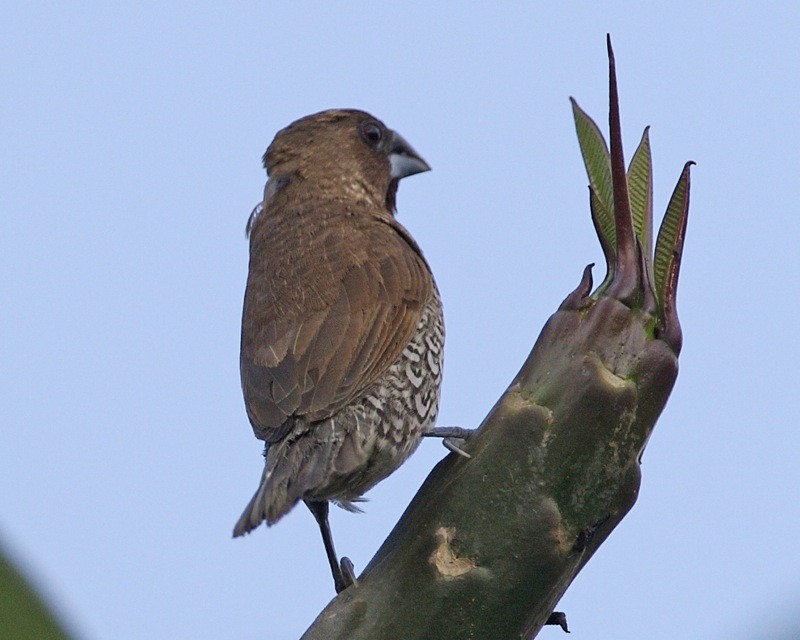Scaly-breasted Munia
A species of Mannikins, Also known as Spotted Munia Scientific name : Lonchura punctulata Genus : Mannikins
Scaly-breasted Munia, A species of Mannikins
Also known as:
Spotted Munia
Botanical name: Lonchura punctulata
Genus: Mannikins
Content
Description People often ask General Info
 Photo By Lip Kee , used under CC-BY-SA-2.0 /Cropped and compressed from original
Photo By Lip Kee , used under CC-BY-SA-2.0 /Cropped and compressed from original Description
The scaly-breasted munia is about 11–12 centimetres (4.3–4.7 in) long and weighs 12–16 grams (0.026–0.035 lb). The adult has a stubby dark bill typical of grain eating birds, brown upperparts and a dark brown head. The underparts are white with dark scale markings. The sexes are similar, although males have darker markings on the underside and a darker throat than females. Immature birds have pale brown upperparts, lack the dark head found in adults, and have uniform buff underparts that can be confused with juveniles of other munia species such as the tricolored munia (Lonchura malacca) across the Asian and island populations and the black-throated munia (Lonchura kelaarti) in parts of India or Sri Lanka. Populations within their wide distribution range show variations in plumage color and size. Along with other Estrildines, these species are thought to have originated in Asia. The species has been introduced to other parts of the world due to its popularity as a cage bird and populations have established in the wild. 
Size
10-12 cm (4-4.75 in)
Life Expectancy
6-10 years
Nest Placement
Tree
Feeding Habits
Scaly-breasted Munia primarily feed on seeding grasses, including rice during milky stages, and a variety of other plants such as Cynodon and Panicum. Scaly-breasted Munia also consume weeds, berries, and algae, supplementing their diet with insects and household scraps. Their feeding behavior consists of foraging on the ground or plants and is adapted to graze on small seeds with their sharp beaks.
Habitat
Scaly-breasted Munia favors a range of terrestrial ecosystems including scrubby grasslands, mangroves, and coastal landfills. Well-adapted to anthropogenic landscapes, they are prevalent in rice paddies, cultivated areas, and wastelands, as well as gardens. Their habitat extends from sea level to elevations of up to 3000 meters in the Himalayas and adjacent regions, showcasing their adaptability to varying moisture environments and altitudes.
Dite type
Granivorous
General Info
Feeding Habits
Bird food type
Bird Feeder Type

Small Hopper

Small Tube Feeder

Platform
Distribution Area
Scaly-breasted munias are found in a range of habitats but are usually close to water and grassland. In India, they are especially common in paddy fields where they are considered a minor pest on account of their feeding on grain. They are found mainly on the plains, but can be observed in the foothills of the Himalayas, in which they may be present at altitudes near 2,500 m (1.6 mi), and in the Nilgiris, where they are found at altitudes up to 2,100 m (6,900 ft) during the summer. In Pakistan, they are restricted to a narrow region from Swat in the west to Lahore, avoiding the desert zone, and then occurring again in India east of an area between Ludhiana and Mount Abu. The species has also been observed in Kashmir, though this is rare. Outside their native range, escaped birds frequently establish themselves in areas with a suitable climate and can then colonize new areas nearby. Escaped cage-birds established in the wild and such populations have been recorded in the West Indies (Puerto Rico since 1971), Hawaii (since 1883), Australia, Japan and southern United States, mainly in Florida and California. In Oahu, Hawaii, they compete for habitats with the tricolored munia and tend to be rare where this competitor is present. 
Species Status
Lonchura punctulata is an abundant species and classified as "least concern" by the International Union for Conservation of Nature (IUCN). The species occupies an extremely large range, and its population, while still unquantified, is large and stable. The scaly-breasted munia is Not globally threatened. and is common to very common throughout most of its range. However, some populations, such as those in the Lesser Sunda Islands are scarce. In many areas it is regarded as an agricultural pest, feeding in large flocks on cultivated cereals such as rice. In Southeast Asia, the scaly-breasted munia is trapped in large numbers for Buddhist ceremonies, but most birds are later released. 
Scientific Classification
Phylum
Chordates Class
Birds Order
Perching birds Family
Estrildid finches Genus
Mannikins Species
Scaly-breasted Munia